Undergraduate Report on Logistics and Supply Chain Management (JNB250)
VerifiedAdded on 2023/04/26
|14
|3517
|89
Report
AI Summary
This report addresses key aspects of logistics and supply chain management within the context of chartering and broking, based on an undergraduate assignment. It begins by examining the parties involved in ship valuation certificates, detailing the roles of creditors, family ownership, and banks. The report then explores the freight market, differentiating between freight and time agreements and analyzing various market schedules like voyage charters. It further delves into the purchase and sales market, new building market, and demolition market, highlighting their significance and the dynamics of each. The final section focuses on specific contractual clauses, including the Himalaya Clause and lien, explaining their implications and functions within shipping agreements. This analysis provides a comprehensive overview of the subject matter.

Running head: LOGISTICS AND SUPPLY CHAIN MANAGEMENT 1
Logistics and Supply Chain Management
Institution’s Name:
Student’s Name:
Logistics and Supply Chain Management
Institution’s Name:
Student’s Name:
Paraphrase This Document
Need a fresh take? Get an instant paraphrase of this document with our AI Paraphraser
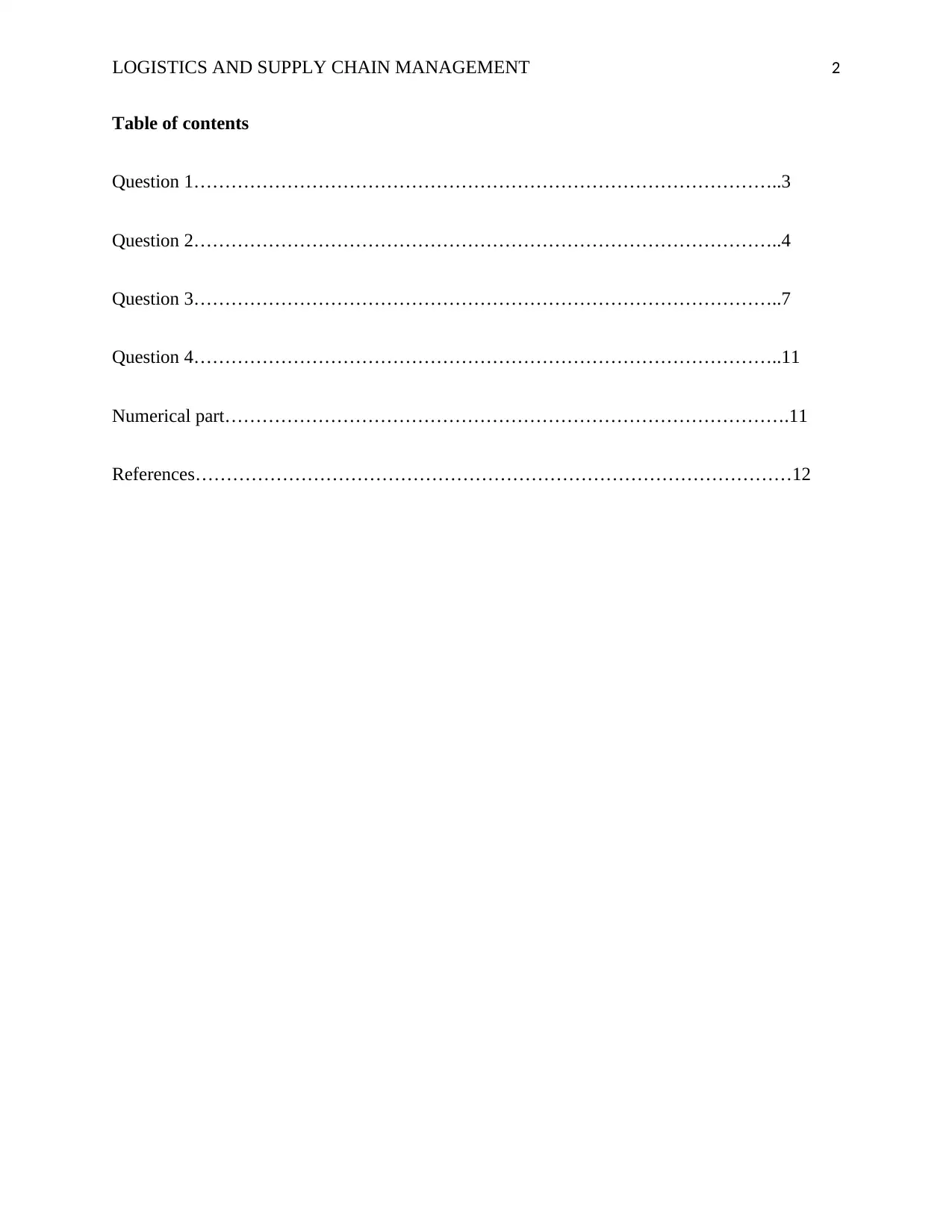
LOGISTICS AND SUPPLY CHAIN MANAGEMENT 2
Table of contents
Question 1…………………………………………………………………………………..3
Question 2…………………………………………………………………………………..4
Question 3…………………………………………………………………………………..7
Question 4…………………………………………………………………………………..11
Numerical part……………………………………………………………………………….11
References……………………………………………………………………………………12
Table of contents
Question 1…………………………………………………………………………………..3
Question 2…………………………………………………………………………………..4
Question 3…………………………………………………………………………………..7
Question 4…………………………………………………………………………………..11
Numerical part……………………………………………………………………………….11
References……………………………………………………………………………………12
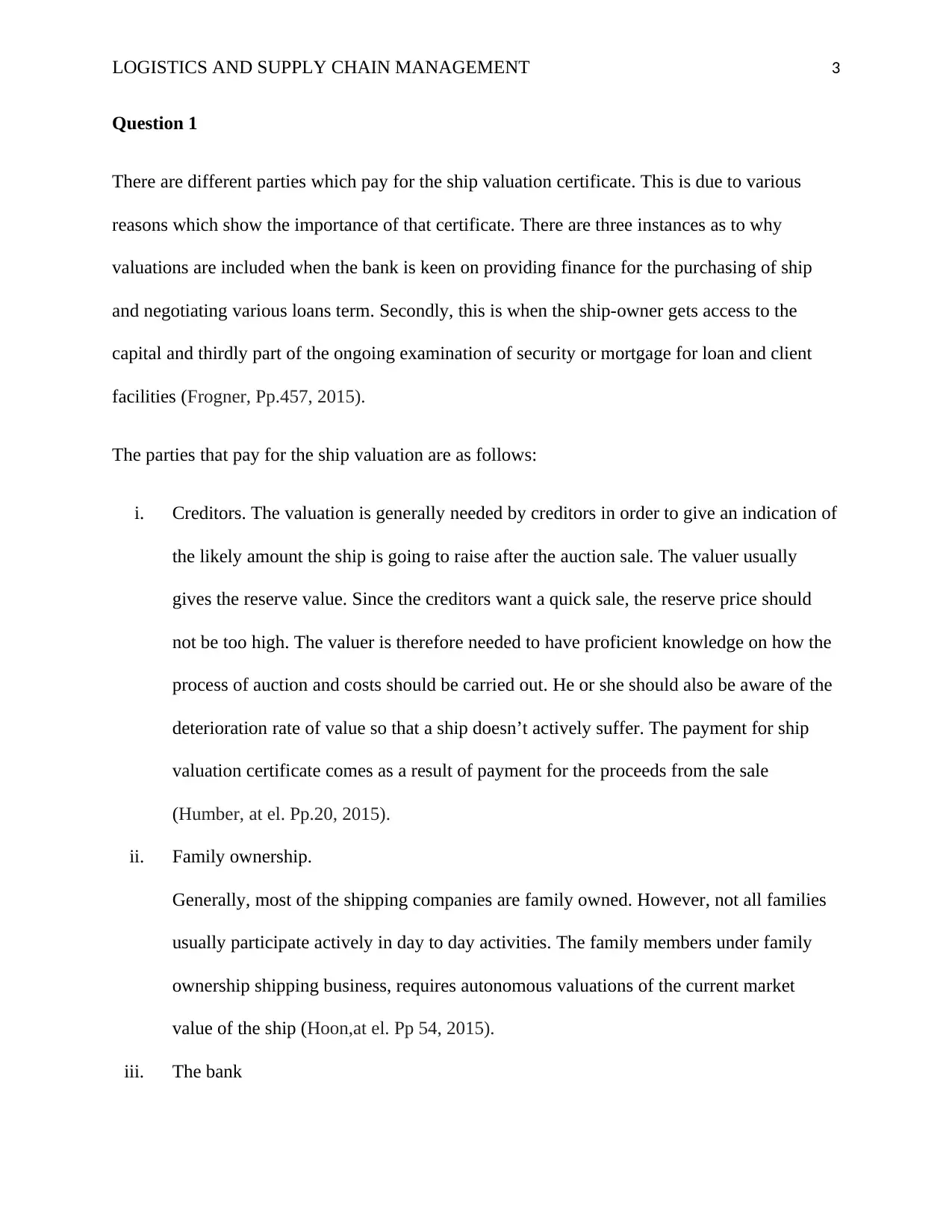
LOGISTICS AND SUPPLY CHAIN MANAGEMENT 3
Question 1
There are different parties which pay for the ship valuation certificate. This is due to various
reasons which show the importance of that certificate. There are three instances as to why
valuations are included when the bank is keen on providing finance for the purchasing of ship
and negotiating various loans term. Secondly, this is when the ship-owner gets access to the
capital and thirdly part of the ongoing examination of security or mortgage for loan and client
facilities (Frogner, Pp.457, 2015).
The parties that pay for the ship valuation are as follows:
i. Creditors. The valuation is generally needed by creditors in order to give an indication of
the likely amount the ship is going to raise after the auction sale. The valuer usually
gives the reserve value. Since the creditors want a quick sale, the reserve price should
not be too high. The valuer is therefore needed to have proficient knowledge on how the
process of auction and costs should be carried out. He or she should also be aware of the
deterioration rate of value so that a ship doesn’t actively suffer. The payment for ship
valuation certificate comes as a result of payment for the proceeds from the sale
(Humber, at el. Pp.20, 2015).
ii. Family ownership.
Generally, most of the shipping companies are family owned. However, not all families
usually participate actively in day to day activities. The family members under family
ownership shipping business, requires autonomous valuations of the current market
value of the ship (Hoon,at el. Pp 54, 2015).
iii. The bank
Question 1
There are different parties which pay for the ship valuation certificate. This is due to various
reasons which show the importance of that certificate. There are three instances as to why
valuations are included when the bank is keen on providing finance for the purchasing of ship
and negotiating various loans term. Secondly, this is when the ship-owner gets access to the
capital and thirdly part of the ongoing examination of security or mortgage for loan and client
facilities (Frogner, Pp.457, 2015).
The parties that pay for the ship valuation are as follows:
i. Creditors. The valuation is generally needed by creditors in order to give an indication of
the likely amount the ship is going to raise after the auction sale. The valuer usually
gives the reserve value. Since the creditors want a quick sale, the reserve price should
not be too high. The valuer is therefore needed to have proficient knowledge on how the
process of auction and costs should be carried out. He or she should also be aware of the
deterioration rate of value so that a ship doesn’t actively suffer. The payment for ship
valuation certificate comes as a result of payment for the proceeds from the sale
(Humber, at el. Pp.20, 2015).
ii. Family ownership.
Generally, most of the shipping companies are family owned. However, not all families
usually participate actively in day to day activities. The family members under family
ownership shipping business, requires autonomous valuations of the current market
value of the ship (Hoon,at el. Pp 54, 2015).
iii. The bank
⊘ This is a preview!⊘
Do you want full access?
Subscribe today to unlock all pages.

Trusted by 1+ million students worldwide
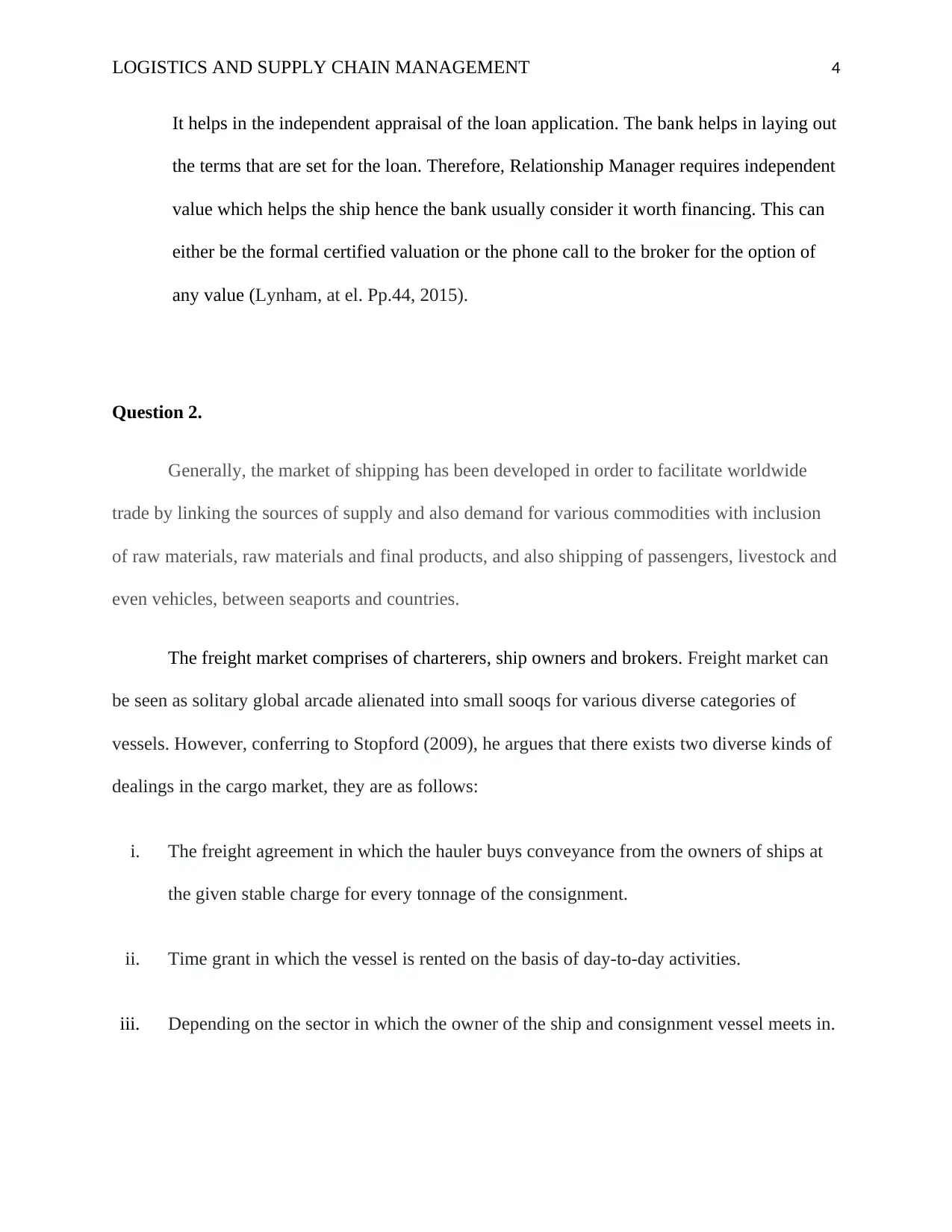
LOGISTICS AND SUPPLY CHAIN MANAGEMENT 4
It helps in the independent appraisal of the loan application. The bank helps in laying out
the terms that are set for the loan. Therefore, Relationship Manager requires independent
value which helps the ship hence the bank usually consider it worth financing. This can
either be the formal certified valuation or the phone call to the broker for the option of
any value (Lynham, at el. Pp.44, 2015).
Question 2.
Generally, the market of shipping has been developed in order to facilitate worldwide
trade by linking the sources of supply and also demand for various commodities with inclusion
of raw materials, raw materials and final products, and also shipping of passengers, livestock and
even vehicles, between seaports and countries.
The freight market comprises of charterers, ship owners and brokers. Freight market can
be seen as solitary global arcade alienated into small sooqs for various diverse categories of
vessels. However, conferring to Stopford (2009), he argues that there exists two diverse kinds of
dealings in the cargo market, they are as follows:
i. The freight agreement in which the hauler buys conveyance from the owners of ships at
the given stable charge for every tonnage of the consignment.
ii. Time grant in which the vessel is rented on the basis of day-to-day activities.
iii. Depending on the sector in which the owner of the ship and consignment vessel meets in.
It helps in the independent appraisal of the loan application. The bank helps in laying out
the terms that are set for the loan. Therefore, Relationship Manager requires independent
value which helps the ship hence the bank usually consider it worth financing. This can
either be the formal certified valuation or the phone call to the broker for the option of
any value (Lynham, at el. Pp.44, 2015).
Question 2.
Generally, the market of shipping has been developed in order to facilitate worldwide
trade by linking the sources of supply and also demand for various commodities with inclusion
of raw materials, raw materials and final products, and also shipping of passengers, livestock and
even vehicles, between seaports and countries.
The freight market comprises of charterers, ship owners and brokers. Freight market can
be seen as solitary global arcade alienated into small sooqs for various diverse categories of
vessels. However, conferring to Stopford (2009), he argues that there exists two diverse kinds of
dealings in the cargo market, they are as follows:
i. The freight agreement in which the hauler buys conveyance from the owners of ships at
the given stable charge for every tonnage of the consignment.
ii. Time grant in which the vessel is rented on the basis of day-to-day activities.
iii. Depending on the sector in which the owner of the ship and consignment vessel meets in.
Paraphrase This Document
Need a fresh take? Get an instant paraphrase of this document with our AI Paraphraser

LOGISTICS AND SUPPLY CHAIN MANAGEMENT 5
Therefore, the freight market involves four sorts of votive schedules: The cruise agreement, the
agreement for affreightment, the time agreement and the bareboat agreement. Vessel owners
contract in order to carry consignment and goods for a settled price per tonnage while the arcade
of the charter leases out ships for a specified period (Braithwaite, pp.805 2012). The charter is
therefore legitimately contracted upon in charter-party cutting-edge which the standings of the
agreement are clearly established out. The ship to hire is static after all of the regulations of type
of agreement and when the freight rate is negotiated upon between the two contracting parties.
According to the (Pantuso, pp.341, 2014) procedure involved is simple, in which, the owner of
the ship has a container for hire, the charterer has got a cargo to engage in transportation, and a
ship broker puts the agreement composed.
The purchase market and sales market, second-hand or scrap ships are merchandised
between the ship owners. The administrative and legal processes used are bumpily similar as to
that in the business of real-estate, through using a standard contract (Manners-Bell and Lyon,
pp.5, 2012). However, trading of ships is a very significant source of a lot of revenue for the ship
owners, since the charges are actually very volatile. Scrap ships or the second hand valuation of
ships entirely depends on rates of freight, ages, inflation and also expectations. The partakers in
this arcade are a blend of shippers, the shipping corporations and also speculators and
shipbrokers represent a very significant part in assigning with the transactions. Trade is between
the owner of the ship and an financier who in general usually is another owner of the ship so
therefore the cash does not leave the purchase and sale market and also from the industry.
Therefore, the freight market involves four sorts of votive schedules: The cruise agreement, the
agreement for affreightment, the time agreement and the bareboat agreement. Vessel owners
contract in order to carry consignment and goods for a settled price per tonnage while the arcade
of the charter leases out ships for a specified period (Braithwaite, pp.805 2012). The charter is
therefore legitimately contracted upon in charter-party cutting-edge which the standings of the
agreement are clearly established out. The ship to hire is static after all of the regulations of type
of agreement and when the freight rate is negotiated upon between the two contracting parties.
According to the (Pantuso, pp.341, 2014) procedure involved is simple, in which, the owner of
the ship has a container for hire, the charterer has got a cargo to engage in transportation, and a
ship broker puts the agreement composed.
The purchase market and sales market, second-hand or scrap ships are merchandised
between the ship owners. The administrative and legal processes used are bumpily similar as to
that in the business of real-estate, through using a standard contract (Manners-Bell and Lyon,
pp.5, 2012). However, trading of ships is a very significant source of a lot of revenue for the ship
owners, since the charges are actually very volatile. Scrap ships or the second hand valuation of
ships entirely depends on rates of freight, ages, inflation and also expectations. The partakers in
this arcade are a blend of shippers, the shipping corporations and also speculators and
shipbrokers represent a very significant part in assigning with the transactions. Trade is between
the owner of the ship and an financier who in general usually is another owner of the ship so
therefore the cash does not leave the purchase and sale market and also from the industry.
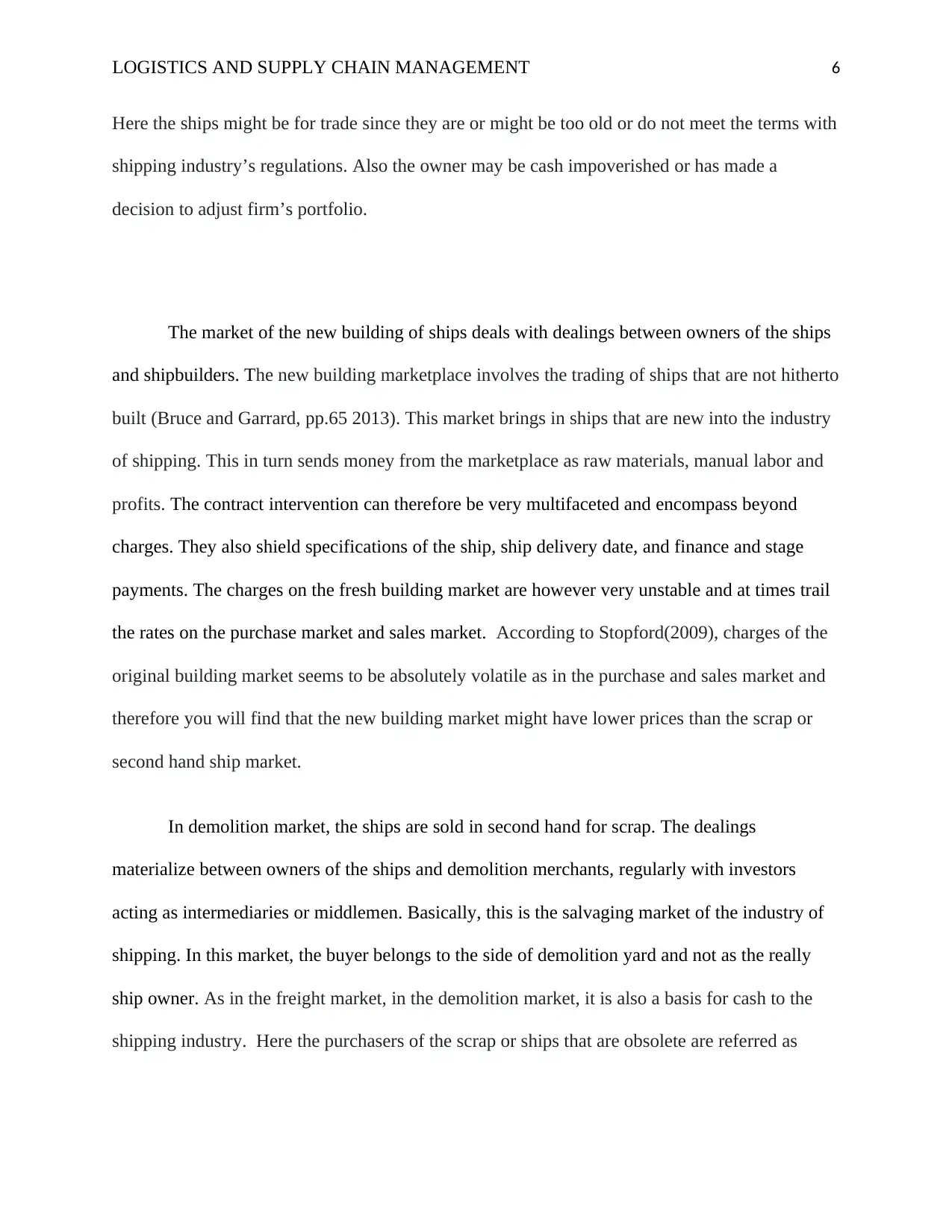
LOGISTICS AND SUPPLY CHAIN MANAGEMENT 6
Here the ships might be for trade since they are or might be too old or do not meet the terms with
shipping industry’s regulations. Also the owner may be cash impoverished or has made a
decision to adjust firm’s portfolio.
The market of the new building of ships deals with dealings between owners of the ships
and shipbuilders. The new building marketplace involves the trading of ships that are not hitherto
built (Bruce and Garrard, pp.65 2013). This market brings in ships that are new into the industry
of shipping. This in turn sends money from the marketplace as raw materials, manual labor and
profits. The contract intervention can therefore be very multifaceted and encompass beyond
charges. They also shield specifications of the ship, ship delivery date, and finance and stage
payments. The charges on the fresh building market are however very unstable and at times trail
the rates on the purchase market and sales market. According to Stopford(2009), charges of the
original building market seems to be absolutely volatile as in the purchase and sales market and
therefore you will find that the new building market might have lower prices than the scrap or
second hand ship market.
In demolition market, the ships are sold in second hand for scrap. The dealings
materialize between owners of the ships and demolition merchants, regularly with investors
acting as intermediaries or middlemen. Basically, this is the salvaging market of the industry of
shipping. In this market, the buyer belongs to the side of demolition yard and not as the really
ship owner. As in the freight market, in the demolition market, it is also a basis for cash to the
shipping industry. Here the purchasers of the scrap or ships that are obsolete are referred as
Here the ships might be for trade since they are or might be too old or do not meet the terms with
shipping industry’s regulations. Also the owner may be cash impoverished or has made a
decision to adjust firm’s portfolio.
The market of the new building of ships deals with dealings between owners of the ships
and shipbuilders. The new building marketplace involves the trading of ships that are not hitherto
built (Bruce and Garrard, pp.65 2013). This market brings in ships that are new into the industry
of shipping. This in turn sends money from the marketplace as raw materials, manual labor and
profits. The contract intervention can therefore be very multifaceted and encompass beyond
charges. They also shield specifications of the ship, ship delivery date, and finance and stage
payments. The charges on the fresh building market are however very unstable and at times trail
the rates on the purchase market and sales market. According to Stopford(2009), charges of the
original building market seems to be absolutely volatile as in the purchase and sales market and
therefore you will find that the new building market might have lower prices than the scrap or
second hand ship market.
In demolition market, the ships are sold in second hand for scrap. The dealings
materialize between owners of the ships and demolition merchants, regularly with investors
acting as intermediaries or middlemen. Basically, this is the salvaging market of the industry of
shipping. In this market, the buyer belongs to the side of demolition yard and not as the really
ship owner. As in the freight market, in the demolition market, it is also a basis for cash to the
shipping industry. Here the purchasers of the scrap or ships that are obsolete are referred as
⊘ This is a preview!⊘
Do you want full access?
Subscribe today to unlock all pages.

Trusted by 1+ million students worldwide

LOGISTICS AND SUPPLY CHAIN MANAGEMENT 7
scrap yard who gobble the ship and thereafter trade in the stall and also other imperative
apparatus and spare parts.
Market becomes an important source of money in the decline and in the direction to retain
balance amongst supply and demand.
Question 3
i. Himalaya Clause.
This is clause that is used in a conveyance agreement purporting to prolong obligation
disadvantages which help the hauler, to others who play the role of agents for the hauler like
the stevedores or longshoremen. It is therefore an article in a bill of lading or conveyance
contract. It also expressed as the benefit for third party that is not included in the contract. It
declares to prolong the liability restrictions that detriment the transporter, and also to those
who may play the role of representatives for hauler like the longshoremen. In such provision
it is articulated to be for an advantage of 3rd party who necessarily may not be a party to the
agreement (Palmer and Davies, pp. 745, 2018). The modern clause states “It is hereby
expressly agreed that no servant or agent of the carrier (including every independent
contractor from time to time employed by the carrier) shall in any circumstances whatsoever
be under any liability whatsoever to the shipper, consignee or owner of the goods or to any
holder of this Bill of Lading for any loss, damage or delay of whatsoever kind arising or
resulting directly or indirectly from any act, neglect or default on his part while acting in the
course of or in connection with his employment and, without prejudice to the generality of
scrap yard who gobble the ship and thereafter trade in the stall and also other imperative
apparatus and spare parts.
Market becomes an important source of money in the decline and in the direction to retain
balance amongst supply and demand.
Question 3
i. Himalaya Clause.
This is clause that is used in a conveyance agreement purporting to prolong obligation
disadvantages which help the hauler, to others who play the role of agents for the hauler like
the stevedores or longshoremen. It is therefore an article in a bill of lading or conveyance
contract. It also expressed as the benefit for third party that is not included in the contract. It
declares to prolong the liability restrictions that detriment the transporter, and also to those
who may play the role of representatives for hauler like the longshoremen. In such provision
it is articulated to be for an advantage of 3rd party who necessarily may not be a party to the
agreement (Palmer and Davies, pp. 745, 2018). The modern clause states “It is hereby
expressly agreed that no servant or agent of the carrier (including every independent
contractor from time to time employed by the carrier) shall in any circumstances whatsoever
be under any liability whatsoever to the shipper, consignee or owner of the goods or to any
holder of this Bill of Lading for any loss, damage or delay of whatsoever kind arising or
resulting directly or indirectly from any act, neglect or default on his part while acting in the
course of or in connection with his employment and, without prejudice to the generality of
Paraphrase This Document
Need a fresh take? Get an instant paraphrase of this document with our AI Paraphraser

LOGISTICS AND SUPPLY CHAIN MANAGEMENT 8
the foregoing provisions of this clause, every exemption, limitation, condition and liberty
herein contained and every right, exemption from liability, defense and immunity of
whatsoever nature applicable to the carrier or to which the carrier is entitled hereunder shall
also be available and shall extend to protect every such servant or agent of the carrier acting
as aforesaid and for the purpose of all the foregoing provisions of this clause the carrier is or
shall be deemed to be acting as agent or trustee on behalf of and for the benefit of all persons
who are or might be his servants or agents from time to time (including independent
contractors as aforesaid) and all such persons shall to this extent be or be deemed to be
parties to the contract in or evidenced by this Bill of Lading.” (Lynham, at el. Pp.44, 2015).
ii. Lien
This clause is generally related with "Lesser clause" in the grant party. The owner for the
ship is moreover given the possessory lien for instance by the common law. In the case
where charterer has botched in making disbursements due to the ship owners under the
standings and conditions of the contract party, therefore the owner for the ship has got a
right of lien in regard to the cargo conferring to the lien clause, the owner of the ships
may keep the general cargo on board (Lempriere, Pp.197, 2014).The ship owner may also
keep the cargo in a store or within a dry land until the amount for the cargo is paid.
Basically under common law, it is referred to as a possessory lien. In general, lien clause
shields this to cover not only the freight that has not been paid for but also the dead
freight, the demurrage, reparations for detention, and in broad-spectrum the average aids
due to the owner of the ship (Light, pp.21, 2016).
the foregoing provisions of this clause, every exemption, limitation, condition and liberty
herein contained and every right, exemption from liability, defense and immunity of
whatsoever nature applicable to the carrier or to which the carrier is entitled hereunder shall
also be available and shall extend to protect every such servant or agent of the carrier acting
as aforesaid and for the purpose of all the foregoing provisions of this clause the carrier is or
shall be deemed to be acting as agent or trustee on behalf of and for the benefit of all persons
who are or might be his servants or agents from time to time (including independent
contractors as aforesaid) and all such persons shall to this extent be or be deemed to be
parties to the contract in or evidenced by this Bill of Lading.” (Lynham, at el. Pp.44, 2015).
ii. Lien
This clause is generally related with "Lesser clause" in the grant party. The owner for the
ship is moreover given the possessory lien for instance by the common law. In the case
where charterer has botched in making disbursements due to the ship owners under the
standings and conditions of the contract party, therefore the owner for the ship has got a
right of lien in regard to the cargo conferring to the lien clause, the owner of the ships
may keep the general cargo on board (Lempriere, Pp.197, 2014).The ship owner may also
keep the cargo in a store or within a dry land until the amount for the cargo is paid.
Basically under common law, it is referred to as a possessory lien. In general, lien clause
shields this to cover not only the freight that has not been paid for but also the dead
freight, the demurrage, reparations for detention, and in broad-spectrum the average aids
due to the owner of the ship (Light, pp.21, 2016).
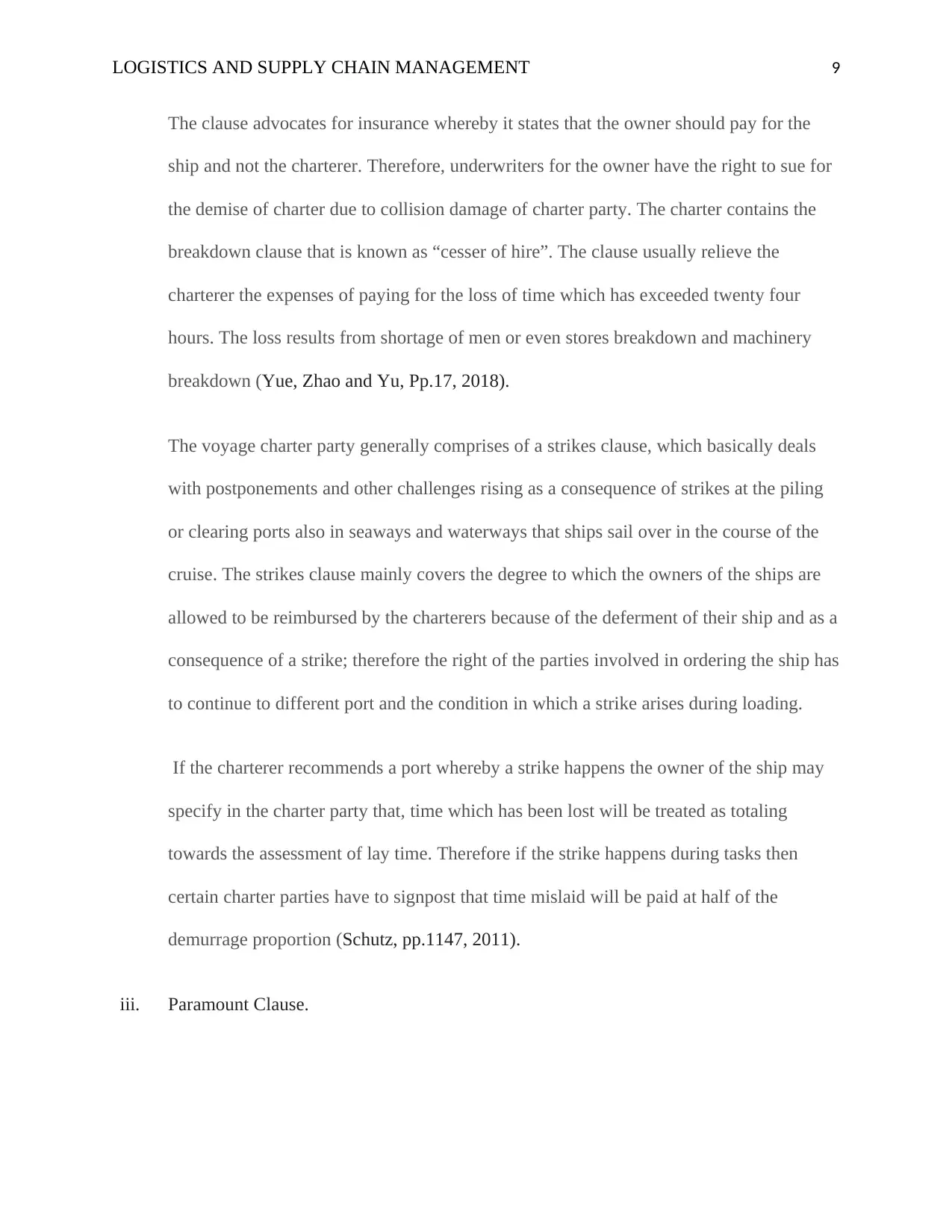
LOGISTICS AND SUPPLY CHAIN MANAGEMENT 9
The clause advocates for insurance whereby it states that the owner should pay for the
ship and not the charterer. Therefore, underwriters for the owner have the right to sue for
the demise of charter due to collision damage of charter party. The charter contains the
breakdown clause that is known as “cesser of hire”. The clause usually relieve the
charterer the expenses of paying for the loss of time which has exceeded twenty four
hours. The loss results from shortage of men or even stores breakdown and machinery
breakdown (Yue, Zhao and Yu, Pp.17, 2018).
The voyage charter party generally comprises of a strikes clause, which basically deals
with postponements and other challenges rising as a consequence of strikes at the piling
or clearing ports also in seaways and waterways that ships sail over in the course of the
cruise. The strikes clause mainly covers the degree to which the owners of the ships are
allowed to be reimbursed by the charterers because of the deferment of their ship and as a
consequence of a strike; therefore the right of the parties involved in ordering the ship has
to continue to different port and the condition in which a strike arises during loading.
If the charterer recommends a port whereby a strike happens the owner of the ship may
specify in the charter party that, time which has been lost will be treated as totaling
towards the assessment of lay time. Therefore if the strike happens during tasks then
certain charter parties have to signpost that time mislaid will be paid at half of the
demurrage proportion (Schutz, pp.1147, 2011).
iii. Paramount Clause.
The clause advocates for insurance whereby it states that the owner should pay for the
ship and not the charterer. Therefore, underwriters for the owner have the right to sue for
the demise of charter due to collision damage of charter party. The charter contains the
breakdown clause that is known as “cesser of hire”. The clause usually relieve the
charterer the expenses of paying for the loss of time which has exceeded twenty four
hours. The loss results from shortage of men or even stores breakdown and machinery
breakdown (Yue, Zhao and Yu, Pp.17, 2018).
The voyage charter party generally comprises of a strikes clause, which basically deals
with postponements and other challenges rising as a consequence of strikes at the piling
or clearing ports also in seaways and waterways that ships sail over in the course of the
cruise. The strikes clause mainly covers the degree to which the owners of the ships are
allowed to be reimbursed by the charterers because of the deferment of their ship and as a
consequence of a strike; therefore the right of the parties involved in ordering the ship has
to continue to different port and the condition in which a strike arises during loading.
If the charterer recommends a port whereby a strike happens the owner of the ship may
specify in the charter party that, time which has been lost will be treated as totaling
towards the assessment of lay time. Therefore if the strike happens during tasks then
certain charter parties have to signpost that time mislaid will be paid at half of the
demurrage proportion (Schutz, pp.1147, 2011).
iii. Paramount Clause.
⊘ This is a preview!⊘
Do you want full access?
Subscribe today to unlock all pages.

Trusted by 1+ million students worldwide
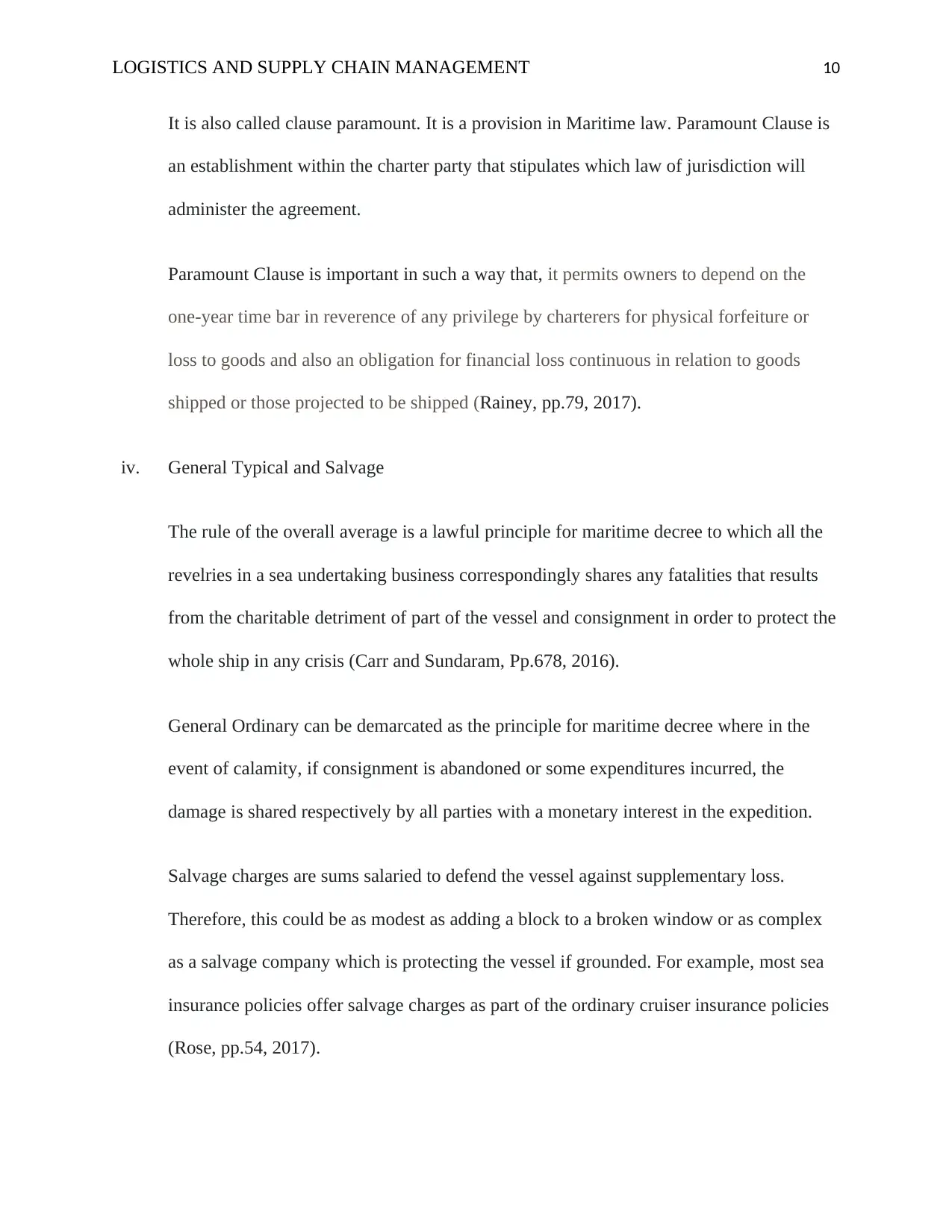
LOGISTICS AND SUPPLY CHAIN MANAGEMENT 10
It is also called clause paramount. It is a provision in Maritime law. Paramount Clause is
an establishment within the charter party that stipulates which law of jurisdiction will
administer the agreement.
Paramount Clause is important in such a way that, it permits owners to depend on the
one-year time bar in reverence of any privilege by charterers for physical forfeiture or
loss to goods and also an obligation for financial loss continuous in relation to goods
shipped or those projected to be shipped (Rainey, pp.79, 2017).
iv. General Typical and Salvage
The rule of the overall average is a lawful principle for maritime decree to which all the
revelries in a sea undertaking business correspondingly shares any fatalities that results
from the charitable detriment of part of the vessel and consignment in order to protect the
whole ship in any crisis (Carr and Sundaram, Pp.678, 2016).
General Ordinary can be demarcated as the principle for maritime decree where in the
event of calamity, if consignment is abandoned or some expenditures incurred, the
damage is shared respectively by all parties with a monetary interest in the expedition.
Salvage charges are sums salaried to defend the vessel against supplementary loss.
Therefore, this could be as modest as adding a block to a broken window or as complex
as a salvage company which is protecting the vessel if grounded. For example, most sea
insurance policies offer salvage charges as part of the ordinary cruiser insurance policies
(Rose, pp.54, 2017).
It is also called clause paramount. It is a provision in Maritime law. Paramount Clause is
an establishment within the charter party that stipulates which law of jurisdiction will
administer the agreement.
Paramount Clause is important in such a way that, it permits owners to depend on the
one-year time bar in reverence of any privilege by charterers for physical forfeiture or
loss to goods and also an obligation for financial loss continuous in relation to goods
shipped or those projected to be shipped (Rainey, pp.79, 2017).
iv. General Typical and Salvage
The rule of the overall average is a lawful principle for maritime decree to which all the
revelries in a sea undertaking business correspondingly shares any fatalities that results
from the charitable detriment of part of the vessel and consignment in order to protect the
whole ship in any crisis (Carr and Sundaram, Pp.678, 2016).
General Ordinary can be demarcated as the principle for maritime decree where in the
event of calamity, if consignment is abandoned or some expenditures incurred, the
damage is shared respectively by all parties with a monetary interest in the expedition.
Salvage charges are sums salaried to defend the vessel against supplementary loss.
Therefore, this could be as modest as adding a block to a broken window or as complex
as a salvage company which is protecting the vessel if grounded. For example, most sea
insurance policies offer salvage charges as part of the ordinary cruiser insurance policies
(Rose, pp.54, 2017).
Paraphrase This Document
Need a fresh take? Get an instant paraphrase of this document with our AI Paraphraser
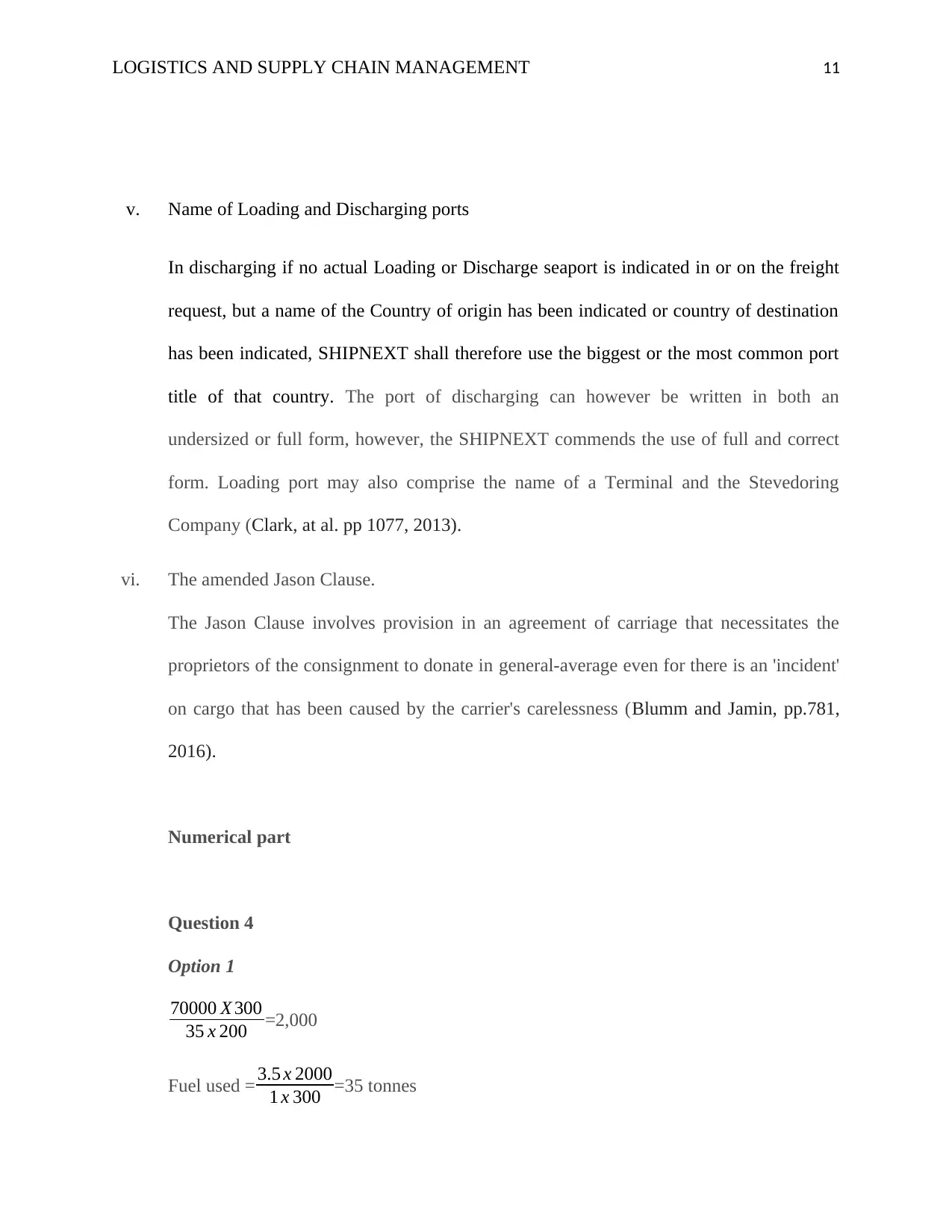
LOGISTICS AND SUPPLY CHAIN MANAGEMENT 11
v. Name of Loading and Discharging ports
In discharging if no actual Loading or Discharge seaport is indicated in or on the freight
request, but a name of the Country of origin has been indicated or country of destination
has been indicated, SHIPNEXT shall therefore use the biggest or the most common port
title of that country. The port of discharging can however be written in both an
undersized or full form, however, the SHIPNEXT commends the use of full and correct
form. Loading port may also comprise the name of a Terminal and the Stevedoring
Company (Clark, at al. pp 1077, 2013).
vi. The amended Jason Clause.
The Jason Clause involves provision in an agreement of carriage that necessitates the
proprietors of the consignment to donate in general-average even for there is an 'incident'
on cargo that has been caused by the carrier's carelessness (Blumm and Jamin, pp.781,
2016).
Numerical part
Question 4
Option 1
70000 X 300
35 x 200 =2,000
Fuel used = 3.5 x 2000
1 x 300 =35 tonnes
v. Name of Loading and Discharging ports
In discharging if no actual Loading or Discharge seaport is indicated in or on the freight
request, but a name of the Country of origin has been indicated or country of destination
has been indicated, SHIPNEXT shall therefore use the biggest or the most common port
title of that country. The port of discharging can however be written in both an
undersized or full form, however, the SHIPNEXT commends the use of full and correct
form. Loading port may also comprise the name of a Terminal and the Stevedoring
Company (Clark, at al. pp 1077, 2013).
vi. The amended Jason Clause.
The Jason Clause involves provision in an agreement of carriage that necessitates the
proprietors of the consignment to donate in general-average even for there is an 'incident'
on cargo that has been caused by the carrier's carelessness (Blumm and Jamin, pp.781,
2016).
Numerical part
Question 4
Option 1
70000 X 300
35 x 200 =2,000
Fuel used = 3.5 x 2000
1 x 300 =35 tonnes
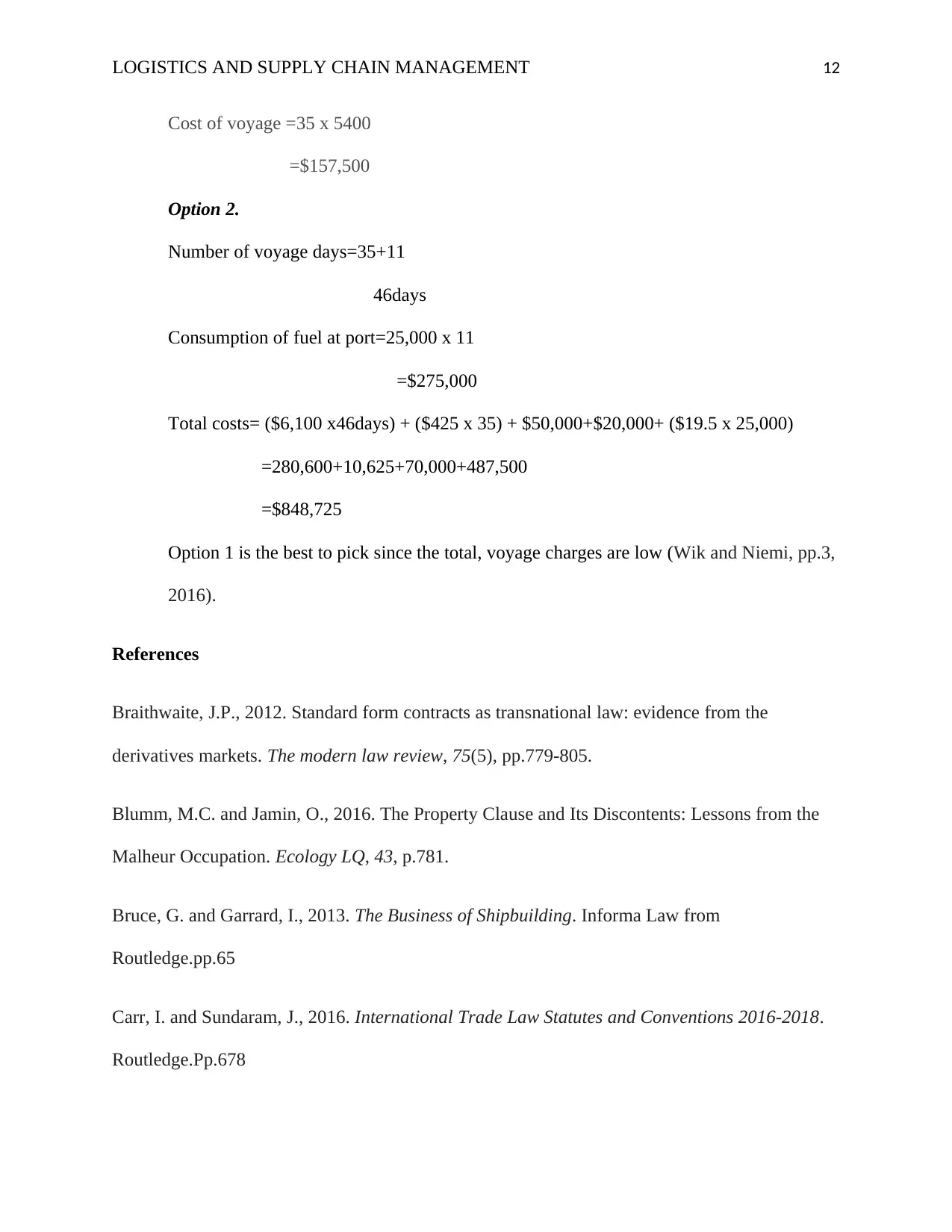
LOGISTICS AND SUPPLY CHAIN MANAGEMENT 12
Cost of voyage =35 x 5400
=$157,500
Option 2.
Number of voyage days=35+11
46days
Consumption of fuel at port=25,000 x 11
=$275,000
Total costs= ($6,100 x46days) + ($425 x 35) + $50,000+$20,000+ ($19.5 x 25,000)
=280,600+10,625+70,000+487,500
=$848,725
Option 1 is the best to pick since the total, voyage charges are low (Wik and Niemi, pp.3,
2016).
References
Braithwaite, J.P., 2012. Standard form contracts as transnational law: evidence from the
derivatives markets. The modern law review, 75(5), pp.779-805.
Blumm, M.C. and Jamin, O., 2016. The Property Clause and Its Discontents: Lessons from the
Malheur Occupation. Ecology LQ, 43, p.781.
Bruce, G. and Garrard, I., 2013. The Business of Shipbuilding. Informa Law from
Routledge.pp.65
Carr, I. and Sundaram, J., 2016. International Trade Law Statutes and Conventions 2016-2018.
Routledge.Pp.678
Cost of voyage =35 x 5400
=$157,500
Option 2.
Number of voyage days=35+11
46days
Consumption of fuel at port=25,000 x 11
=$275,000
Total costs= ($6,100 x46days) + ($425 x 35) + $50,000+$20,000+ ($19.5 x 25,000)
=280,600+10,625+70,000+487,500
=$848,725
Option 1 is the best to pick since the total, voyage charges are low (Wik and Niemi, pp.3,
2016).
References
Braithwaite, J.P., 2012. Standard form contracts as transnational law: evidence from the
derivatives markets. The modern law review, 75(5), pp.779-805.
Blumm, M.C. and Jamin, O., 2016. The Property Clause and Its Discontents: Lessons from the
Malheur Occupation. Ecology LQ, 43, p.781.
Bruce, G. and Garrard, I., 2013. The Business of Shipbuilding. Informa Law from
Routledge.pp.65
Carr, I. and Sundaram, J., 2016. International Trade Law Statutes and Conventions 2016-2018.
Routledge.Pp.678
⊘ This is a preview!⊘
Do you want full access?
Subscribe today to unlock all pages.

Trusted by 1+ million students worldwide
1 out of 14
Your All-in-One AI-Powered Toolkit for Academic Success.
+13062052269
info@desklib.com
Available 24*7 on WhatsApp / Email
![[object Object]](/_next/static/media/star-bottom.7253800d.svg)
Unlock your academic potential
Copyright © 2020–2025 A2Z Services. All Rights Reserved. Developed and managed by ZUCOL.